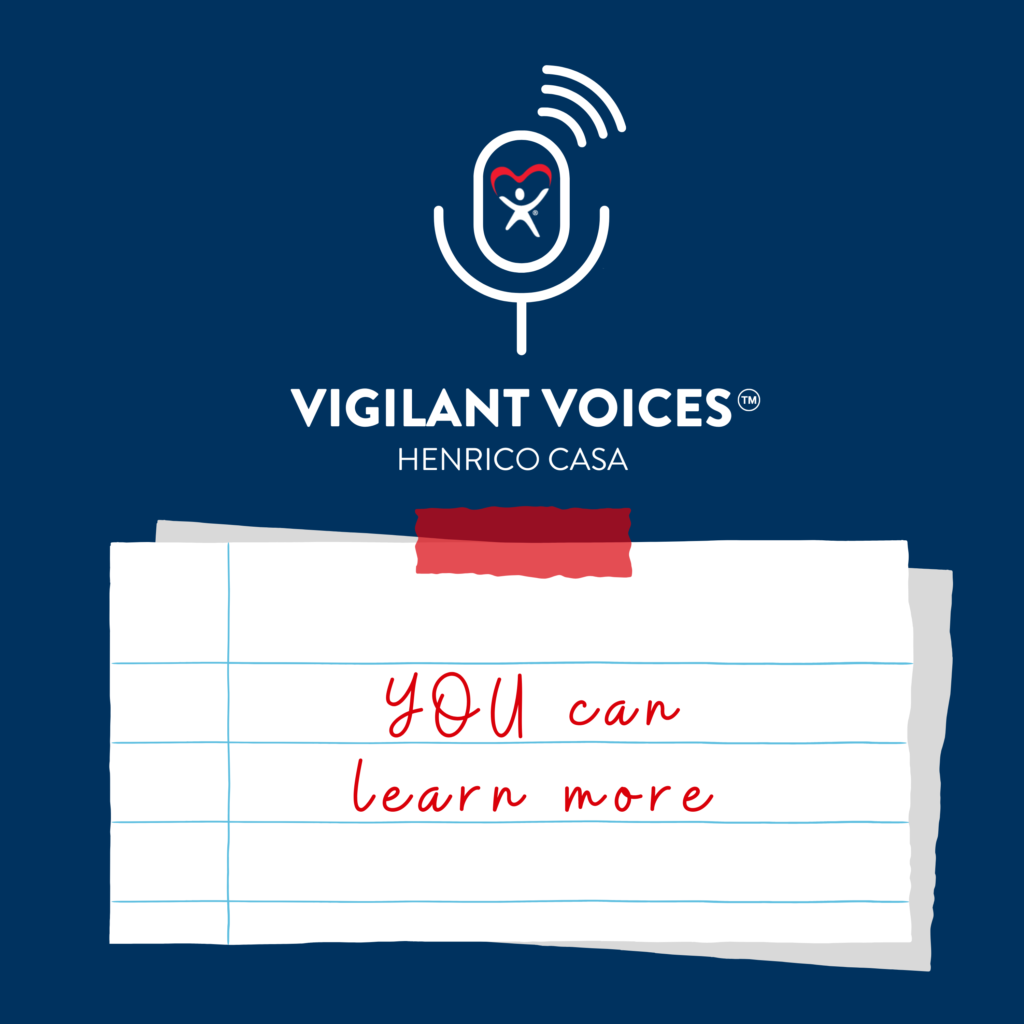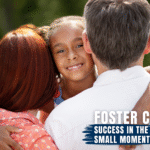
Listen to Episode 11 of the Vigilant Voices™ podcast, YOU Can Learn More.
Kristin Blalock: Hello, listeners. Thanks for joining us for another episode of Henrico CASA’s Vigilant Voices™ podcast.
Jeannine Panzera: We are happy to have you with us because we continue to believe that the more we know about the challenges facing children and families, the more effective we can be at ensuring no child faces additional abuse, neglect, or trauma.
K: And for us and our team at CASA, part of knowing is reading, because everyone on our staff loves a good book, whether they’re reading it or listening to it, whether it’s nonfiction, fiction, biography, self help,
J: and all the other gazillion categories that are out there.
K: Right. Part of reading is entertainment. But the other part that specifically applies to this podcast is our desire to be continuous learners.
J: Exactly. So when we learn, and especially learning things different, we know better, and then we can do better.
K: Yes. We’re always trying to do better, which makes me think of one of our CASA volunteers who is an avid reader, and he sends us book reports on what he reads, which we love. So one of his book reports last year was a review of What Happened to You, which is a collaboration between Dr. Bruce Perry and Oprah.
J: Can we be sure to link this Kristen in our notes? Because this is a fantastic book, and actually, listener, we’re going to be talking about books in today’s episode, so we will put a link to all of our books.
K: Sure. I’ll pop it online. Okay, so to give you a CASA story today, we wanted to talk to you about one of the children that this book report writing volunteer advocated for over the years. This was a boy who we will call Ryan. And Ryan was really born into a tough situation.
J: So when you think about the concept of what happened to you as the title of this book is called, Ryan’s list was long. He lived in a home with pretty severe substance abuse and mental health issues. He experienced a loss of family members. He experienced a traumatic event of being removed from the home that he knew and placed into foster care, was separated from his siblings. So he had a lot going on.
K: Oh, for sure. And on top of that, Ryan lives with autism, so he had many unmet needs when his CASA first met him. And we were so glad he was paired with an advocate who was able to take the time to really know him and learn more about the behaviors associated with children who have experienced trauma.
J: Absolutely. And we just love that our volunteers are lifelonglearners and they read, and then they can apply what they learn through those books to their cases.
K: And again, reading is what today’s episode is all about. So, Jeannine, what have you been reading that you think our listeners should know about?
J: It’s a great question. Lots of good books. But, you know, Kristin, that I like to read, leadership books and, of course, what’s going on in the business world. You know, think of the OG: Good to Great and other titles. But actually, that is what led me to a book called GRIT by Angela Duckworth. Really interesting. And it explores the concept of applying perseverance and passion to long term goals.
K: Oh, you already pulled me in because I love the concept of grit. I kind of think of it as stick-with-it-ness, if that’s a word.
J: Well, and I’ve even heard the term stickiness too. And so I started reading the book thinking about personal development, leadership, goals. But then, as usual, my mind actually quickly shifted to the work that our volunteers do here at Henrico CASA. And the principles in the book are so related to volunteerism, but specifically the work that our advocates do.
K: Yeah. I mean, our volunteers make such a commitment. They invest their time, their life experiences, their professional skills into making a positive difference in a child’s life. And their desire to be the good in the world is really inspirational to me.
J: Absolutely. I mean, there’s no doubt at all. And our volunteers come from very different backgrounds which we celebrate. But we also see a lot of similarities and commonalities kind of those internal traits. I see tenacity and perseverance and that desire to serve. That’s why they’re giving back. And so then the entire time I was reading this book, I couldn’t stop thinking about these amazing people who volunteer their time and then the way that they demonstrate the author’s explanation and really, in some ways, definition of grit.
K: I’m so glad you saw such a correlation there. I know the book lays out key components of this characteristic that you’re calling grit. So walk us through them.
J: Hoping that you’d ask me to share more! So within the book, there are really five components that really stood out to me that relates to our work, our volunteers, and frankly, really anyone committed to promoting the best interests of children. So the first is passion and purpose, which, having a passion fuels dedication and enthusiasm around a mission.
K: I can see that. When we go through training with our CASA volunteers, it always feels so exciting. Like they’ve come to us with a passion for helping children. And through training them to be advocates, we’re, in essence, giving them a purpose. It’s their opportunity to act on the passion they brought to the table.
J: And that passion is contagious. And what they quickly learn, though, is besides the passion, they need perseverance. And that’s the second component of grit. Being a CASA volunteer sometimes involves facing challenges with system setbacks, roadblocks, obstacles.
K: And having grit allows them to persist while staying focused on the children that they’re committing to serve.
J: I love the saying, when the going gets tough, the tough get going. And our volunteers are so tough.
K: Yes, they are!
J: And they also have a growth mindset, which is the third component of grit. I am constantly amazed, well, generally at our volunteers, but how they also work diligently to improve their skills, to become more effective in their advocacy. They do a ton of continuing education, which is required, but they embrace it. But then they also show resilience, which is the fourth component of grit.
K: Interesting, because we often talk about resilience in terms of the children we serve who experience trauma and they’ve built resilience in response to that.
J: I totally agree with you. And that’s what really made me think a little bit differently in this case about resilience and the resilience that our volunteers do show every day. So they develop that ability to bounce back from setbacks, adapt to changing circumstances, move around and through complicated systems and roadblocks. But all the while they’re maintaining that commitment to the children they so selflessly serve.
K: Okay, so that’s passion, perseverance, growth mindset, and resilience. What was the fifth characteristic of grit that resonated with you?
J: Long term commitment. Grit also demands a long-term commitment to achieving meaningful goals. You can’t just think you’re going to do something right and magically.
K: Yeah, it takes time. And being a CASA volunteer is definitely an illustration of that type of long term commitment.
J: It really is. I’m so proud that our amazing volunteers commit to their role for many, many years, making a direct and meaningful and lasting impact on our community.
K: And you know, it’s funny because the long term nature of volunteering with CASA and again, listener, just in case we haven’t said it enough, that stands for Court Appointed Special Sdvocate. But that long term nature is often the biggest hesitation people have when they reach out to us, wanting to get involved. But the funny thing is it’s also the biggest reward because having that long term relationship with a child is what makes the work so rewarding and impactful. It’s a meaningful investment that you’re making in someone’s life and there’s a real opportunity for positive change. But that doesn’t happen overnight.
J: No. And there’s also a lot of studies that show there’s great health benefits to volunteering and giving back. All right. And so Kristin, that was my book and I want to hear about maybe a book recommendation you have for me or for us. But because we’re talking about CASA, I want to give a little plug for some recruitment efforts. And so, listeners, we are recruiting volunteers to join our fall training session which will begin in September. And so we’ll put a link to more information about that in our show notes.
K: Definitely. And if you’re listening, on the first Tuesday in August when this episode drops, there’s actually an information session coming up on Thursday, August 10, so definitely check out our website.
J: Cool. All right, so after the plug, tell us about a book.
K: So, I recently read Childhood Disrupted, which was written by Donna Jackson Nakazawa. I hope I’m saying your last name correctly, Donna! I discovered this book after I came across a quote by Donna, the author. She said, “the best thing we can do for the children we care for is to manage our own stuff. Adults who have resolved their own trauma help kids feel safe.”
J: There is so much truth in that statement.
K: Oh, my gosh. Without a doubt. And when I saw the quote, it was actually on this little handout with a visual of many different paths we can pursue to healing. And so that whole kind of healing circle really intrigued me. And then I looked up her book.
J: That’s really interesting. I assume, based on just this real quick snippet that you’ve shared so far, that the book is about ACES, and, listener, in case you missed any of our previous episodes on ACES, it stands for: Adverse Childhood Experiences.
K: You’re right. The book is definitely about ACEs. And, I mean, you and I both have read a ton about ACEs over the years. There’s so much data out there and material, and it’s just fascinating. It’s all about the way our experiences can actually change our brain and physical systems beyond our brain. It just blows my mind.
J: Yeah, mine too. It’s a really interesting correlation.
K: But this book was different because it wasn’t like all the facts and data .It was much more personal. So it was full of stories of adults who were, as an adult, trying to identify medical diagnoses and learning that their conditions were really rooted all the way back in their childhoods, back when they endured adverse experiences that were just too much for their little bodies and brains to process. And so for me, this book, the stories, really brought the data that I’ve known about to life.
J: Wow, that’s amazing. I’m definitely intrigued. So I saw the cover of the book – I haven’t read it – and I noticed that the tagline is “how your biography becomes your biology and how you can heal.” So did it speak to some of that healing?
K: Oh, it did. And seriously, that’s another reason why I love this book, because so often when you read about ACEs, there’s data and an explanation of the connection between childhood trauma and adult health issues… but it kind of leaves you hanging like, okay, so there’s a connection, but now what?
J: Right. Or, well, now what can we do now that we know that a child has experienced trauma and now they’re adults, but they likely have all of these other issues? And so not that we want to feel helpless, but what do we do?
K: Well, this book definitely does not leave you feeling helpless. The whole premise is that there should be no fear or hopelessness in knowing you may have had a number of adverse childhood experiences. And that may mean you’re more likely to experience certain challenges as an adult
J: or potentially you’re not because they’re not necessarily for sure.
K: Either way, there is definitely freedom in knowing because then you can be aware and you can seek help for healing. And there’s so many ways to move forward towards healing on your own or with professional help .In this book, I actually counted 31actionable suggestions that the author had.
J: That’s amazing. I always love when there’s tangible ideas, next steps offered for healing or just takeaways that we can actually do, right?
K: And I’ll just point out the other thing that really stood out to me from this book was that studies show that children who have experienced these traumatic events that we’re always talking about, like losing a parent, they don’t necessarily have more negative moods or emotions than their peers. They do, however, lack positive feelings to kind of counter balance those negatives.
J: Can you explain that like a little bit more?
K: Yeah, I can. And I’m probably going to butcher this because it’s a little confusing now that I’m trying to explain it, but the study looked at, I think it was 40 mood words and found that all kids experience the same negative moods. But the difference for kids with traumatic backgrounds is that what their peers may be thought of as positive actually brings a flood of negative emotions to them. So let me give you an example. Like being in an affectionate mood. A child with a safe, secure childhood feels positive emotions with that. They love affection, they want to be hugged, touched, cuddled. But a child with a traumatic background may feel negative emotions related to affection. Again, I’m probably butchering this a little bit, but does that make sense?
J: Yeah, I think actually it does. It’s almost like the scales are tipped more heavily to the negatives for kids with those adverse experiences.
K: Right. And like Ryan in our CASA story, early in his childhood he didn’t have many positive experiences balancing out the really extreme negatives. But his CASA was able to speak up for his needs and help turn things around. Ryan ended up actually being separated from his sibling, which is always sad, but he was able to be placed with a foster parent who was specifically skilled at caring for children with disabilities and he was later adopted by this family, so he gained a forever home.
J: I love that. And I actually remember a nice added little bonus was that this foster family was wonderful and maintained that connection for Ryan and his siblings. His CASA had read so much about how children who have such severe trauma need regulation and connectedness in order for interventions to be most successful. And Ryan gained that in his new home.
K: Oh, that’s awesome. And kids like these don’t have positive memories to fall back on, necessarily. They don’t have warm feelings to comfort them. If emotions were on a scale, there wouldn’t be enough on the positive side of that scale to balance out the negative side. Which makes me wonder, how can we give children more positives to just tip their scale that direction?
J: Well, and maybe that’s a fantastic way to end this episode with our normal call to action. So, listeners, what positives are you putting out there to the children in your life? Little smiles or hugs? Kind words, just even, like, intentional eye contact?
K: All of those little things will tip the scales towards the positive, so start focusing on them!








